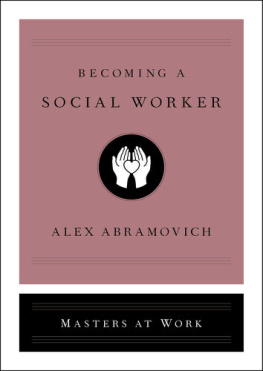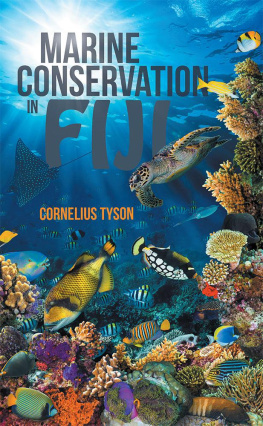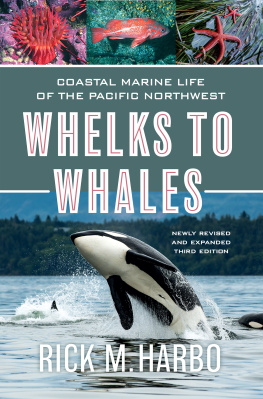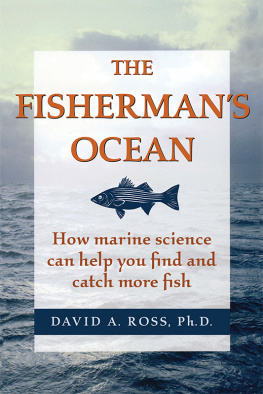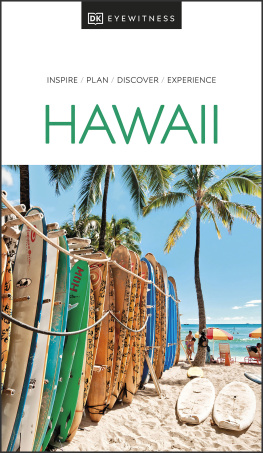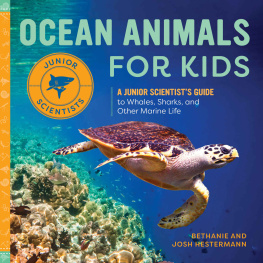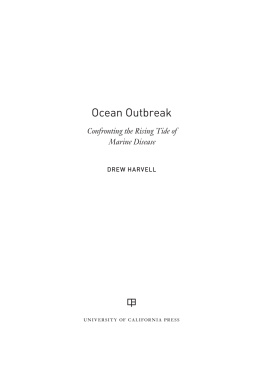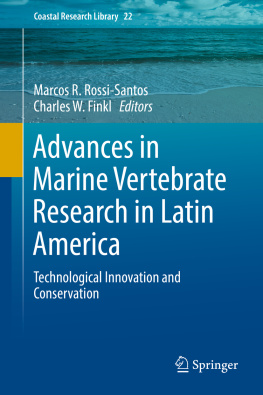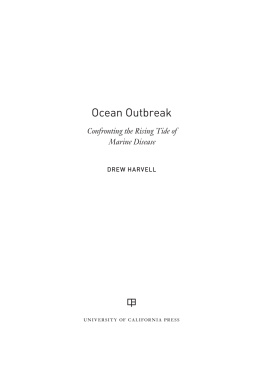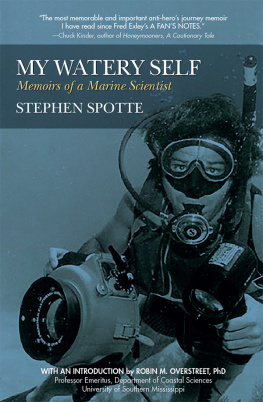I N MEMORY OF MY PARENTS, WHO SHARED WITH ME THEIR LOVE OF THE NATURAL WORLD, ITS SPECIAL PLACES, AND ALL ITS CREATURES.
F in! shouted Colin Cornforth. Theres a fin up! He squinted at the horizon. Three animals. Make that four at eleven oclock. Rissos, maybe. Chopping the air with the side of his hand, Cornforth, a captain with a tour company in Kona, Hawaii, pointed in the direction the dolphins were traveling.
Dr. Robin Baird nodded and steered the twenty-four-foot Zodiac toward the animals but didnt increase his speed. Baird has been studying the behaviors of the whales and dolphins of the Hawaiian Islands for almost twenty years. He knew that the sound of a boats motor frightens some sea mammals, and did not want to spook them. Rissos dolphins are a rarely seen species hes targeted on this two-week survey off the Big Island of Hawaiipart of his long-term study of the cetaceans (the general term for whales and dolphins) that live or spend time in the islands waters.
Ive got seven animals now! Cornforth called out from the prow.
Baird nodded again and smiled. Only fifteen minutes prior, Cornforth and the three other crew members had been muttering, bored by Bairds choice of routes for the day. The team had left the Kona dock at 5:25 a.m., and headed north to these waters. We were six miles offshore, where the sea extends nearly a mile and a half below the surface. Its the region Baird most loves to explore. This is where the pelagic species live, he explained, using the term for deepwater sea creatures, such as false killer whales, beaked and Brydes whales, rough-toothed and Rissos dolphins. These are animals that people dont often see.
There was no guarantee, of course, that we would see them, either. Dolphins dont leave tracks or scents as land mammals do. The only way to find them is by motoring around and sighting a fin in the distance, or a splash and some spray. You might get luckyor you might not. And wed been unlucky for almost six hours. Moments before spotting the Rissos dolphins, Cornforth had grousedjust loud enough for me to hearthat the day was being wasted traveling across this desert.
Baird, a tall and beefy ginger-haired man with eyes as blue as the sea, stood beneath the shady shelter of his inflatable boats canvas awning. For someone with such fair skin, Hawaiis sun and the glare from the water posed a danger, and he dressed accordingly: long-sleeved shirt, long pants, and visorand now and then rubbed more sunscreen over his nose and cheeks. He didnt react to Cornforths jibe. After all, hed used the word desert himself when describing the region to me the day before. The Hawaiian Islands, Baird explained, create oases in the midst of the Pacific Oceans desertso named because its largely poor in nutrients. The trade winds and ocean currents stir only the surface waters, except around the islands; their size and height break up the winds and currents so that the cold, nutrient-rich waters of the deep mix with the warm, oxygen-poor surface waters, causing the water to bloom with phytoplankton, the microscopic algae that are the basis of the oceans food webs. Where phytoplankton are abundant, so are squid and fish, and their predators, including dolphins and whales.
Twenty-five species of cetaceans live near the Hawaiian Islands. Eighteen are odontocetes: toothed animals such as common bottlenose and Rissos dolphins, and killer and sperm whales. The other seven are baleen whales (also known as mysticetes), such as humpback, fin, and blue whales, which have plates of baleen (made of the protein keratin) that sieve the water as they feed on plankton and krill. Most touristsand most scientiststypically see only two of these twenty-five species: humpback whales and spinner dolphins, which are easy to spot from shore or on whale-watching cruises. Baird has made the other twenty-three species his specialty.
Hawaii was a very crowded place for whale researchers when I first came here in 1998, he told me. But it was only crowded if you were studying the obvious suspects. Indeed, as Baird began to search for his niche, he made a discovery: in the preceding thirty years, nearly every research article about Hawaiis cetaceans focused on either humpbacks or spinner dolphins. At the time, this sort of concentration on one or two species wasnt unusual in cetacean research. For example, most researchers in British Columbia, Canada, focused only on killer whales, while a few also studied gray whales. That left plenty of room for an observant and determined young scientist to build his own research project, Baird realized. And so he did.
Of course, doing so wasnt easy or straightforward. He was poor most of the time and stressed by the need to secure grants, get boats and crews, digest the data they collected, and write papersoften simultaneously. But over time, he made discoveries and published enough papers that other cetacean experts tipped their hats to his accomplishments.
I never would have thought you could do what Bairds donesee these rare cetaceans regularly enough to gather the kind of data he has, said Scott Baker, a conservation geneticist and cetacean specialist at the Oregon State University Marine Mammal Institute. Like many of the young marine biologists at the University of Hawaii in the 1980s, Baker had researched humpback whales for his dissertation. But Robin saw the potential in these offshore, more unpredictable species. His work has helped fill in some big gaps. The two men met in the early 1980s at a conference and now collaborate on a number of projects to study and conserve cetaceans.
Baird has never given his project an official title. He refers to it simply as our Hawaii research or Hawaii cetaceans. Officially, hes a research biologist with Cascadia Research Collective in Olympia, Washington, a nonprofit research and education organization that he joined in 2003. Through the collective, he applies for grants and contracts primarily from US government agencies such as the National Marine Fisheries Service (NMFS), the Pacific Islands Fisheries Science Center (PIFSC), the Marine Mammal Commission (MMC), and the US Navy. One approximately $100,000 grant to study the islands populations of false killer whalesfive to six foot long cousins of killer whales; they have a pale blaze between their pectoral fins and a light stripe down the belly but otherwise are almost solidly dark graycame from NMFSs Bycatch Reduction Engineering Program, an effort to lower the number of these whales caught accidentally by fishers. The funds covered the costs of the survey I joined, as well as the subsequent data analysis and report preparation, and contributed to Bairds and his team members salaries.
T EN MINUTES AFTER C ORNFORTH first spotted the Rissos dolphins, Baird managed to work his boat just behind them. About two dozen swam ahead of us, rising quickly and rhythmically to expel the air in their lungs before inhaling and diving back into the water. The air filled with the whoosh of their wet breaths. In the distance, they appeared silvery white, with dark, rounded heads and hooked dorsal fins. Closer up, we could see that theyre actually gray-black in hue, the front half of their bodies crisscrossed with intricate white scars resembling scribbled gang graffiti. Newborn Rissos have black backs and sides, Baird explained, but the animals become lighter as they age and accumulate scars from playing and fightingand from being attacked by both their prey (squid) and their predators (sharks).
This is only our eleventh encounter in eighteen years with this species, Baird said, and weve only put a satellite tag on one, so we dont know a lot about their behaviors. He stood behind the steering wheel, slowly and steadily scanning the waters, keeping an eye on the Rissos while checking the horizon for other dolphins or whales.

